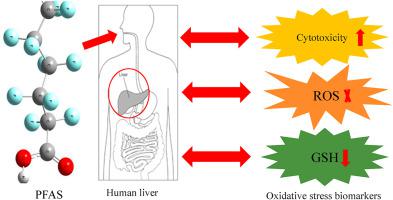Chemosphere ( IF 8.1 ) Pub Date : 2021-05-05 , DOI: 10.1016/j.chemosphere.2021.130808 Atinuke F Ojo 1 , Qing Xia 1 , Cheng Peng 1 , Jack C Ng 1

|
Although human exposure is to mixtures of per- and polyfluoroalkyl substances (PFAS), their combined effects and underlying mechanisms remain largely unknown. In this study, the combined effects of PFAS was investigated by treating human liver cells (HepG2) with various concentrations of perfluorooctanoic acid (PFOA), perfluorooctane sulfonate (PFOS), perfluorodecanoic acid (PFDA), perfluorononanoic acid (PFNA), and perfluorohexanoic acid (PFHxS) individually or in binary combinations (PFOS + PFOA, PFOS + PFDA, PFOS + PFNA, PFOS + PFHxS, PFOA + PFDA, PFOA + PFNA, and PFOA + PFHxS) for 24 h using an orthogonal design. The individual and binary combination effects of PFAS on the cytotoxicity, intracellular reactive oxygen species (ROS) production, and glutathione (GSH) levels were determined by MTS assay, dichlorofluorescein diacetate assay, and GSH-Glo™ Glutathione assay, respectively. The results showed that exposure to PFOA, PFOS, PFDA, PFNA, and PFHxS individually and in binary combinations caused concentration-dependent cytotoxicity to HepG2 cells. Also, intracellular ROS production was not significantly induced in both the individual and co-treatment groups, indicating that ROS production may not be likely influencing the combined cytotoxicity of PFAS to HepG2 cells. However, the depletion of the intracellular glutathione levels was correlated with cytotoxicity. Moreover, the factorial analysis results showed no significant interactive effects between PFOS + PFOA, PFOS + PFDA, PFOS + PFNA, PFOS + PFHxS, PFOA + PFDA, PFOA + PFNA, and PFOA + PFHxS. Taken together, the results showed that both individual and combined PFAS could induce concentration-dependent cytotoxicity and depletion of GSH levels, but could not induce significant increases in ROS production at the concentration range tested. Overall, these results provided valuable toxicological data on the combined effects of mixed PFAS that may help to better assess their human health risk.
中文翻译:

使用氧化应激的生物标志物评估全氟烷基物质对人肝细胞的单独和联合毒性
尽管人类接触的是全氟烷基物质和多氟烷基物质(PFAS)的混合物,但它们的综合作用和潜在机理仍然未知。在这项研究中,通过用各种浓度的全氟辛酸(PFOA),全氟辛烷磺酸(PFOS),全氟癸酸(PFDA),全氟壬酸(PFNA)和全氟己酸处理人肝细胞(HepG2),研究了PFAS的联合作用(PFHxS)单独或以二进制组合(PFOS + PFOA,PFOS + PFDA,PFOS + PFNA,PFOS + PFHxS,PFOA + PFDA,PFOA + PFNA和PFOA + PFHxS)连续24小时使用正交设计。通过MTS分析,二氯荧光素二乙酸盐分析确定PFAS对细胞毒性,细胞内活性氧(ROS)产生和谷胱甘肽(GSH)水平的个体和二元联合作用,和GSH-Glo™谷胱甘肽检测。结果表明,单独和二元组合暴露于PFOA,PFOS,PFDA,PFNA和PFHxS会对HepG2细胞产生浓度依赖性的细胞毒性。同样,在个体和共同治疗组中均未显着诱导细胞内ROS产生,这表明ROS产生可能不会影响PFAS对HepG2细胞的联合细胞毒性。但是,细胞内谷胱甘肽水平的降低与细胞毒性有关。此外,析因分析结果表明,PFOS + PFOA,PFOS + PFDA,PFOS + PFNA,PFOS + PFHxS,PFOA + PFDA,PFOA + PFNA和PFOA + PFHxS之间没有显着的交互作用。在一起 结果表明,单独和联合使用的PFAS都可以诱导浓度依赖性的细胞毒性和GSH的消耗,但是在所测试的浓度范围内,不能诱导ROS的产生显着增加。总体而言,这些结果提供了有关混合全氟辛烷磺酸综合作用的有价值的毒理学数据,可能有助于更好地评估其人类健康风险。











































 京公网安备 11010802027423号
京公网安备 11010802027423号